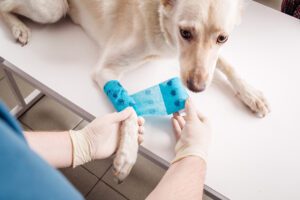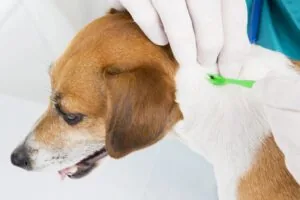Behavior Problems: Canine Anxiety

Anxiety is probably the most common type of behavior problem in dogs. For most dogs, stress plays a key role in the development of an anxiety problem but there may also be a breed predisposition in some cases. It is important to understand that anxiety in dogs is a medical condition and requires veterinary attention and careful management.
Signs to Watch Out for Include:
- Mild fears: signs may include trembling, tail tucked, withdrawal, hiding, avoiding eye contact, reduced activity, and passive escape behaviors
- Panic: signs may include active escape behavior, and increased, out-of-context, potentially injurious motor activity
- Classic signs of sympathetic autonomic nervous system activity, including diarrhea
- Anxieties: lesions secondary to anxious behavior (such as licking and biting at the self)
- Destructive behavior such as digging, chewing furniture, scratching at door frames etc.
- Aggression to other dogs or people.
To accurately diagnose an anxiety problem, you’ll need to provide information about your dog’s behavioral and medical history. Your veterinarian will ask lots of questions and also perform a thorough physical exam and possibly blood and urine tests, especially if your dog’s treatment plan includes medication.
Causes of Fear and Anxiety in Dogs
- Any illness or painful physical condition can increase anxiety and contribute to the development of fears, phobias, and anxieties
- Aging changes associated with nervous system changes; infectious disease (primarily viral infections in the central nervous system), and toxic conditions, such as lead poisoning, may lead to behavioral problems, including fears, phobias, and anxieties
- Fear from a terrible experience; dog may have been forced into an unfamiliar and frightening experience
- Dogs that are deprived of social and environmental exposure at a young age may become habitually fearful
- Phobias and panic may result from the inability to escape or get away from the stimulus causing the phobia and panic, such as being locked in crate
- Separation anxiety: history of abandonment, multiple owners, rehoming, or prior neglect is common; exacerbating the condition may be that the dog has been often abandoned or rehomed because of separation anxiety
Diagnosis of Fear and Anxiety in Dogs
Your veterinarian will first want to rule out other conditions that might be causing the behavior, such as brain or thyroid disease. The behavior could also be originating from a response to a toxic substance, such as lead. Blood tests will rule out or confirm such a possibility.
There are medications that can be given to dogs to help with their anxiety, based on your individual dog, the fear trigger, and types of behavioral techniques that can be used to alleviate your dog’s fears and anxieties. However, drugs are not for every pet. Talk to your vet to see what the best option would be. There are also homeopathic products that help with stress and anxiety as well.
As long as your dog is on medications, your veterinarian will want to follow-up visits and occasional blood testing to make sure your dog’s blood chemicals stay in balance. If behavior modification does not work over the long term, your veterinarian may want to modify the approach. If left untreated, these disorders are likely to progress. Most forms of treatment will be done over the long term, possibly years. It generally depends on the duration and intensity of symptoms, as well as a number of symptoms the dog displays. Minimum treatment averages four to six months.
As the pet owner, you can greatly influence behavior modification. Work with your dog to teach him to relax in a variety of environmental settings. Avoid punishment for behavior related to fear, phobia, or anxiety. Desensitize your dog over time through carefully repeated, controlled exposure to what causes the anxiety. Learn to recognize the physical signs of your pet’s anxiety and work to calm and reassure your pet early on, before it has a chance to take over their behavior. When possible, make adjustments to your pet’s environment that can help, such as adding night lights if your dog is afraid of the dark, or bringing them inside if they are afraid of thunderstorms.
With time, patience and help from your veterinarian, your dog can overcome most fears, phobias and anxieties and go on to live a happy, healthy life!
Share This Post
Recent Posts
About Shallowford Animal Hospital
Shallowford Animal Hospital and The Pet Spa at Shallowford are dedicated to the exceptional, compassionate care your pet deserves. Pets hold a very special place in our families, and we treat yours like our own.



